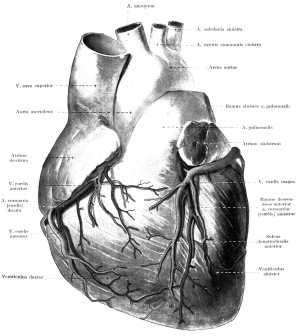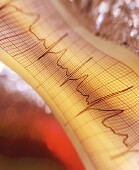- Double Mastectomy May Offer No Survival Benefit to Women With Breast Cancer
- Toxic Lead Found in Cinnamon Product, FDA Says
- Certain Abbott Blood Sugar Monitors May Give Incorrect Readings
- Athletes Can Expect High Ozone, Pollen Counts for Paris Olympics
- Fake Oxycontin Pills Widespread and Potentially Deadly: Report
- Shingles Vaccine Could Lower Dementia Risk
- Your Odds for Accidental Gun Death Rise Greatly in Certain States
- Kids From Poorer Families Less Likely to Survive Cancer
- Tough Workouts Won’t Trigger Cardiac Arrest in Folks With Long QT Syndrome
- At-Home Colon Cancer Test Can Save Lives
A-Fib Doesn’t Mean You’re Banished to the Sidelines


FRIDAY, Jan. 10Cutting back on exercise, or stopping altogether, might seem like the right move for people whose heart beats too fast and erratically, a condition called atrial fibrillation. But that’s not necessarily so.
In fact, staying active — biking, swimming, perhaps even playing pickup basketball, for instance — might be just what the doctor ordered.
The key, heart experts say, is to make sure the heart rate doesn’t go above a certain level, or that exercise doesn’t trigger an uncontrolled heart rhythm.
“There’s a very common misunderstanding that a lack of exercise can help prevent heart rhythm problems, and that’s not true for the far majority of people,” said Dr. Emile Daoud, a cardiologist and chief of the cardiac electrophysiology section at Ohio State University’s Wexner Medical Center in Columbus, Ohio.
“If you have atrial fibrillation, don’t presume that you shouldn’t exercise,” Daoud said. “Ask your doctor what’s safe for you. Some people with atrial fibrillation have other cardiovascular issues that might limit exercise, but for most people, moderate amounts of exercise probably help.”
The heart has its own electrical system that controls the rate and rhythm of the heartbeat. “If you have atrial fibrillation, it means that the pacemaker God gave you isn’t exactly working the way it’s supposed to,” said Dr. Jerry Insel, chief of cardiology at MedStar Good Samaritan Hospital in Baltimore.
Normally, the electrical signal travels from the atria at the top of the heart to the ventricles at the bottom of the heart. If this electrical system malfunctions, the heart doesn’t beat properly, and can’t pump blood to the rest of the body efficiently, according to the U.S. National Heart, Lung, and Blood Institute.
In atrial fibrillation, the atria and the ventricles pump at different rates, which can allow blood to pool, increasing the risk for blood clots. That puts people with atrial fibrillation at an increased risk for stroke, often necessitating blood-thinning medications to keep clots from forming when the heart is beating irregularly.
People with atrial fibrillation may also take medication to control their heart rate. And, if that isn’t enough to restore a normal heart rhythm, doctors may opt to shock the heart back into a normal rhythm with electrical cardioversion.
Some people have short, infrequent episodes of atrial fibrillation, while others have persistent a-fib. Even those with persistent atrial fibrillation, however, may be able to exercise without a problem, Insel said.
Both doctors said that the decision on whether someone with atrial fibrillation can exercise, though, has to be made on an individual basis, based on the type of atrial fibrillation they have and their body’s response to exercise.
“Exercise can be an issue for some people,” Insel said. “With aerobic activity, the heart rate can go up a lot faster. With resistance exercise, it may go slower,” he explained.
“It’s hard to predict what someone’s initial response to exercise will be, so I tell my patients to take it slow,” Insel said. “Start with walking — walking in the house or in the mall — to see what happens with the heart rate. If it goes up above 150 to 160, we may need to prescribe medication.”
But overall, Daoud said, “once we know that the heart muscle is good, and it’s just an electrical problem, we try to encourage people to return to as normal a lifestyle as possible.”
And, Daoud added, “Like everything else in life, moderation is important. For the average person who likes to exercise 45 minutes to an hour in the gym or playing tennis, that type of exercise probably won’t promote a-fib. If you like tennis, go out and play tennis, enjoy. If you have an episode of a-fib while playing, stop and rest for a bit. If you have another episode while you’re playing, stop and don’t exercise for the rest of the day.”
But that doesn’t mean that exercise is out altogether. “It’s important to note that telling people not to exercise won’t stop a-fib from happening,” Daoud said.
In fact, Daoud said there are very few activities he considers off-limits for people with atrial fibrillation. His only rule: “Nothing that makes you grunt,” he said, which means heavy weight-lifting is out. But walking, golf, tennis, swimming, biking, even team sports like soccer or basketball may be OK, he said.
The bottom line, according to Insel, is that “the risk factors that contribute to atrial fibrillation are only helped by activity, so work out a plan with your physician on how to stay active safely.”
More information
The American Heart Association has more about atrial fibrillation.
Read this HealthDay story about a Maryland man who doesn’t let atrial fibrillation get in his way.
Source: HealthDay
Copyright © 2024 HealthDay. All rights reserved.










